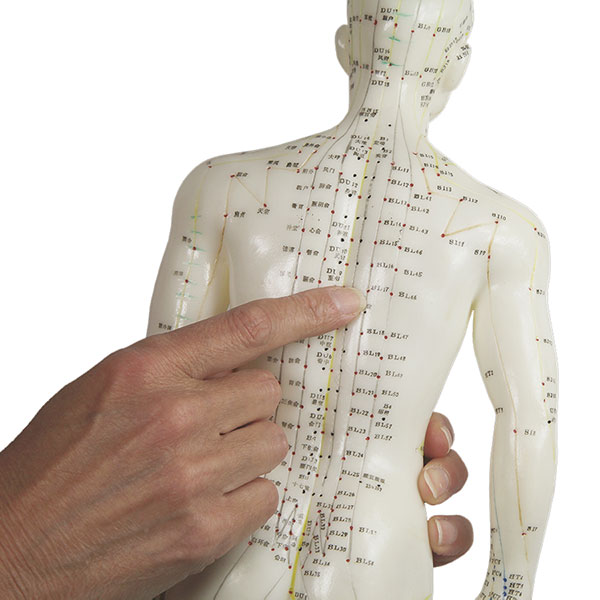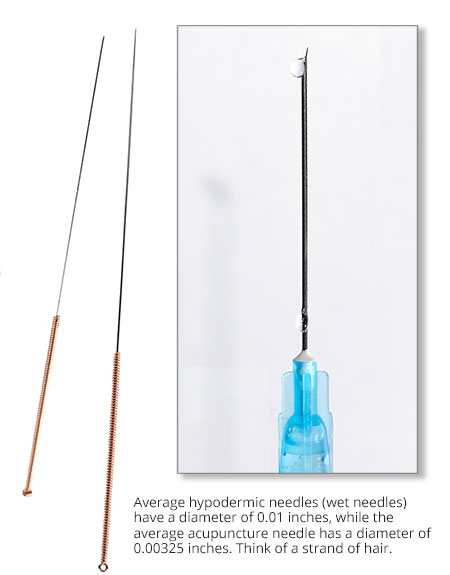
Dry needling is a style of acupuncture that focuses on releasing pain by placing needles into hyperirritable muscle spots called trigger points. Trigger points develop in tight bands of muscle and surrounding connective tissue called fascia. They occur as the result of trauma, repetitive motion, poor biomechanics or stress on the muscles.
Trigger points often occur in tandem with muscle knots, in which the layers of muscle tissue become tight, adhere to each other and form a painful thickening in the muscle.
These points are painful when pressed and often cause pain in other areas of your body, called referred pain. For example, a trigger point in your neck can cause pain in your shoulder or arm, or it can radiate upward and cause painful headaches.
The term dry needling simply means that solid acupuncture needles are used in the treatment, and no substance is inserted into the body. In contrast, a wet needle is one that’s used for administering shots or for delivering intravenous fluids. The term dry needling is also used to identify a specific technique that involves musculoskeletal pain relief through the needling of trigger points.
Scientists believe that dry needling works by increasing circulation to the area and creating an involuntary twitch, or contraction, in the muscle that releases tightness and pain. They also hypothesize that needling into a trigger point reduces the electrical activity, which calms the neuromuscular activity in the point, which reduces pain.
Dry needling evolved differently from the ancient traditions of acupuncture. Western doctors and researchers in the 1930’s and 1940’s began treating muscle pain by injecting an irritant, such as saline into painful muscles. This led to the discovery of trigger points and their ability to cause referred pain in areas away from the original point.
Ultimately, doctors discovered that they could relieve pain without actually injecting any substance into the hyperirritable points; that simply needling into them was enough to deactivate the point.
Is Dry Needling Acupuncture?
Here is where it gets a little complicated. The answer is yes, dry needling is a kind of acupuncture. However it’s been given the name dry needling to distinguish it from traditional acupuncture, which treats not only hyperirritable trigger points, but many other health conditions—and it has been around for thousands of years.
Dry needling and acupuncture are different systems of healing—one Eastern in origin and the other Western. They differ in their methods of evaluation and diagnosis, treatment strategies and underlying goal of treatment. Where dry needling is focused on treating musculoskeletal pain through the treatment of trigger points, the focus of acupuncture is somewhat broader.

Clearly, one focus of acupuncture is to relieve the patient’s symptoms, however the goal of a treatment is to address the underlying cause of those symptoms, too. A principle in acupuncture is that by treating the source of the problem, it produces a permanent solution rather than just addressing superficial symptoms.
Acupuncture is a term to describe a system of healing that originated in China, which involves sophisticated methods of diagnosis and treatment that have been refined over time through research and clinical practice.
Research has uncovered a number of physiological changes that occur throughout the body during and after a traditional acupuncture treatment. Acupuncture can reduce inflammation, calm your parasympathetic nervous system (the opposite of fight or flight), increase circulation, activate neurotransmitters in your brain and affect the balance of your hormones.
An acupuncturist has between 2,500 and 3,000 hours of education, a master’s or doctorate degree and has passed a number of licensing exams. They have studied Chinese medical theory, needling techniques, herbal medicine and acupuncture clinical medicine.
They’ve done this alongside studying Western medicine in the form of anatomy, physiology, pathophysiology, emergency medicine, nutrition, medical screening, pharmacology, herb and drug interactions, and they must be able to work in a germ-free space.
Do Acupuncturists Perform Dry Needling?
 Yes, as a result of their extensive education and certification, acupuncturists are able to perform dry needling. They are highly skilled in the effective needling of the acupuncture points throughout your body.
Yes, as a result of their extensive education and certification, acupuncturists are able to perform dry needling. They are highly skilled in the effective needling of the acupuncture points throughout your body.
Acupuncture practitioners have spent years studying the dynamics of each acupuncture point. They know the depth and direction in which to insert a needle into each individual point, and they are very clear as to what lies below each and every point that they needle. This translates into safe needling practices.
As a part of their education, acupuncturists are trained in trigger point acupuncture, release of hyperirritable muscles and specific techniques to reduce muscle knots. In fact, most of the trigger points commonly used in dry needling are actually acupuncture points.
Knowing that dry needling is a form of acupuncture, acupuncturists that are licensed by their state boards are qualified to perform dry needling. However, some states allow people who are not acupuncturists to perform acupuncture in the form of dry needling with less stringent requirements and fewer training hours than for acupuncturists.
In fact, some practitioners, such as physical therapists or massage therapists are able to perform dry needling with fewer than 100 hours of training and no prior needling experience. This is largely due to political lobbying by members of other professions to use acupuncture needles in their treatments without the same intensive training or certification that’s required of acupuncturists.
This is unfortunate for health consumers for a number of reasons. First, it’s confusing and hard for patients to understand the benefits of dry needling and how to find a qualified practitioner. Second, dry needling is being presented as a therapy separate from acupuncture when it is, in fact, acupuncture. And third, practitioners performing dry needling with the minimum hours of training necessary increases the risk of adverse needling events.
The solution is clear; ask about the credentials of your practitioner, and if you decide to undergo dry needling as a therapy, make sure it’s performed by a licensed acupuncturist. They’re experts in dry needling and many other acupuncture techniques, and it ensures that your treatment is performed safely by a skilled and experienced practitioner.
Have questions about Dry Needling? – Contact us for more information.
